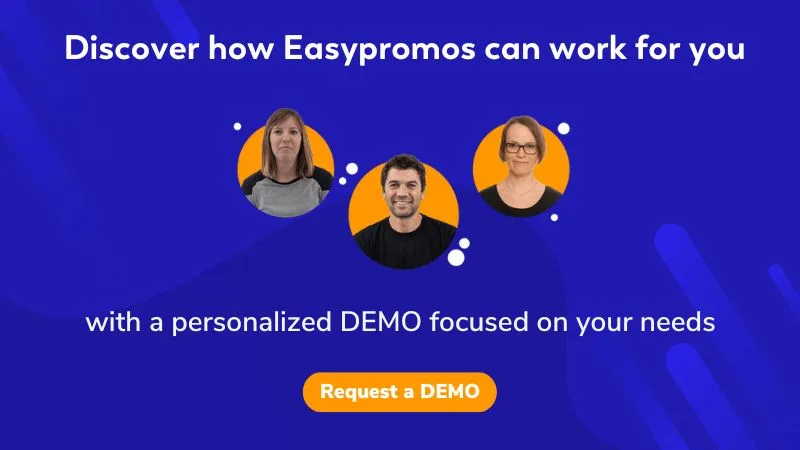Traditional social media content, such as photos, videos, or links to blogs, often gets lost in the endless scroll. Digital games, on the other hand, are a magnet for attention. Whether it’s a puzzle, a word search, or a trivia quiz, users voluntarily spend time interacting with your brand, which increases retention and strengthens brand recall. Offering prizes or giveaways further increases participation and reach through shares, mentions, and comments.
From social media users to zero-party data
Social media platforms come with many uncertainties: algorithm changes, limited organic reach, account bans, and even full-on platform shutdowns in certain regions. That’s why owning your audience’s data is critical. Zero-party data – information that users willingly provide – offers a stable and compliant way to continue engaging with your audience beyond social media platforms.
With social media games, you can incentivize users to share their data in exchange for fun and the chance to win something. Easypromos games integrate customizable registration forms, allowing you to ask for name, email, preferences, location, or any other relevant information. You can also include:
- Mandatory acceptance of terms & conditions and privacy policy.
- Optional consent for receiving communications via email, SMS, or messaging apps like WhatsApp.
- Segmentation tags for targeted marketing in your CRM.
Many types of social media games
With Easypromos, you don’t need to hire a developer or spend weeks building a game from scratch. The platform provides an intuitive game builder, which doesn’t require any programming knowledge, so you can easily customize the game to match your brand and your campaign.
There are different types of games to choose from; picture games like puzzle and memory, word games like word search and crossword puzzles, video-type games like tap tap and minesweeper, and quizzes.
Picture games
These games are highly visual and keep users focused on branded imagery throughout the experience, prolonging the time users are exposed to your brand. These types of games, therefore, naturally reinforce brand recognition, as users view your visuals while solving the challenges.
In this example, the Cat (heavy construction equipment) dealership, WesTrac Australia, celebrated Easter with their audience with an Easter egg hunt, which they shared on their social media profiles on Instagram and Facebook. They also published posts reminding users to participate before the game finished, and used their social profiles to announce the winners.
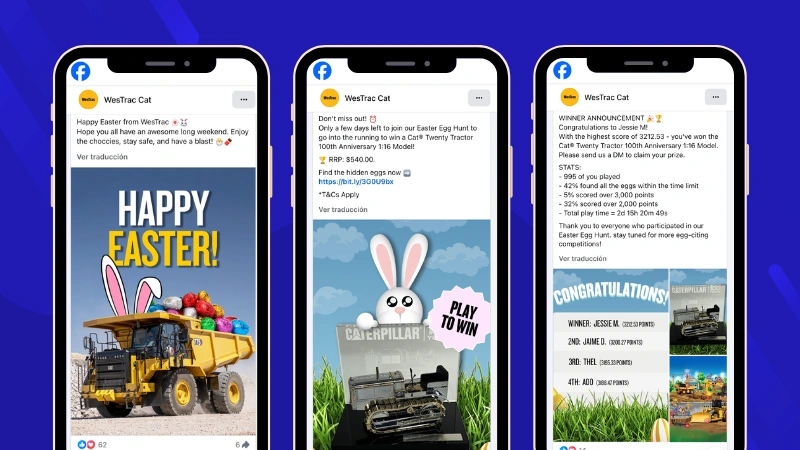
The Easter egg hunt was a Hidden Objects game where users had to find 15 Easter eggs well hidden in the cartoon-style image of a building site within 3 minutes. The fastest user to find all the eggs out of the 995 participants was the lucky winner of a model tractor of the brand valued at AUD 540.
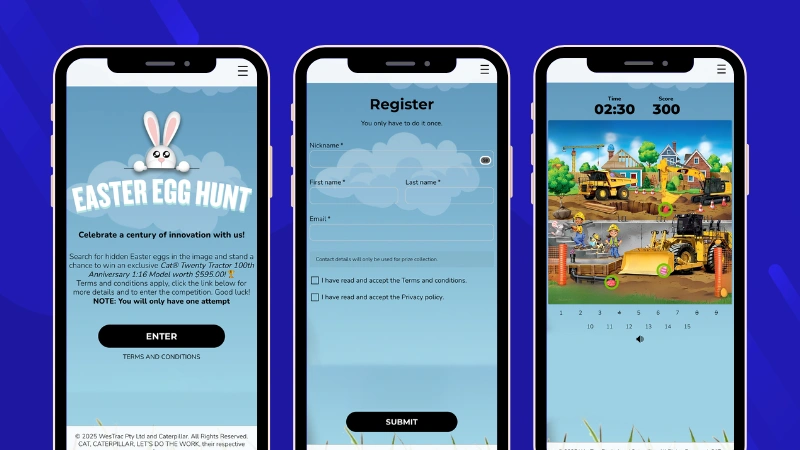
Another picture game is this Match It game from Ecovidrio, a non-profit organization responsible for managing the recycling of all glass packaging waste in Spain. Users accessed the game through the social media posts on Facebook and Instagram, where the organization posted about the game several times.
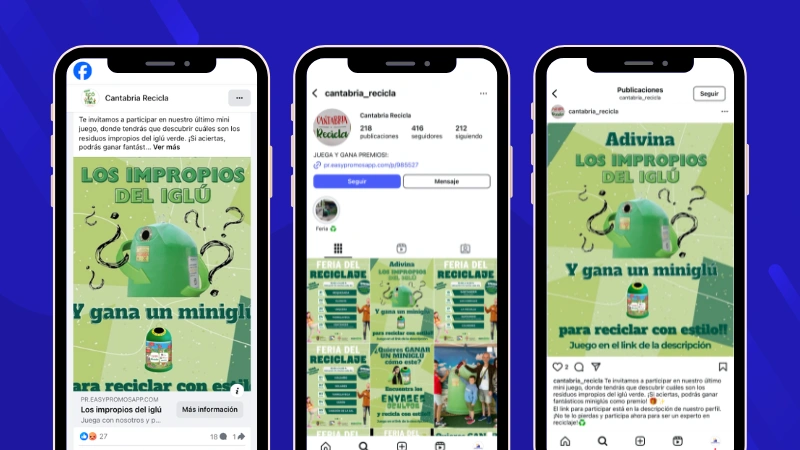
In the game, users had to match the waste items with the correct recycling bin. The items are waste that don’t go in the glass recycling container, so with this game, the organization educated the users on how to recycle correctly. Users had 45 seconds to match 4 waste items with their correct recycling bin, but only 9 moves to do so. Users could play as many times as they wanted. After the participation period, the organization ran a random draw to find three winners who each won one of their mini glass recycling containers for the kitchen.
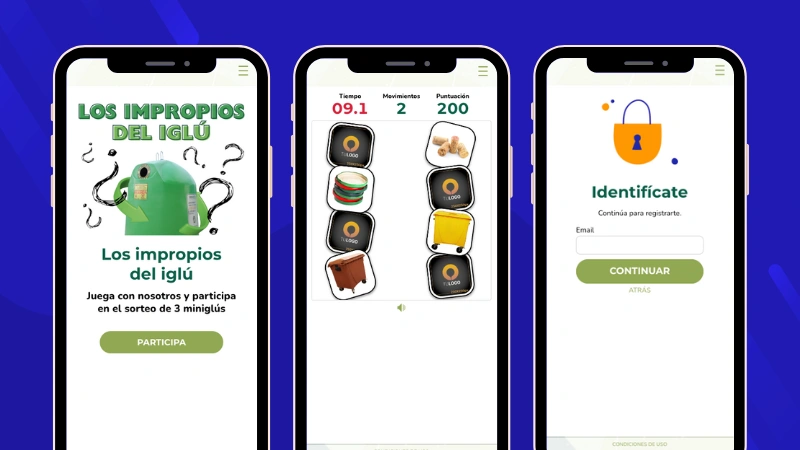
Video-type skill games
These games are inspired by old-style computer and arcade games, and require more reflexes than knowledge. Users are entertained and challenged while being exposed to your brand image. Games like this are perfect for creating competition among the participants and therefore encouraging recurring visits.
For International Women’s Day, Logali used The Tower game to celebrate women in SAP. Posting about the social media game on their profiles helped reach more people who could potentially be interested in their courses.
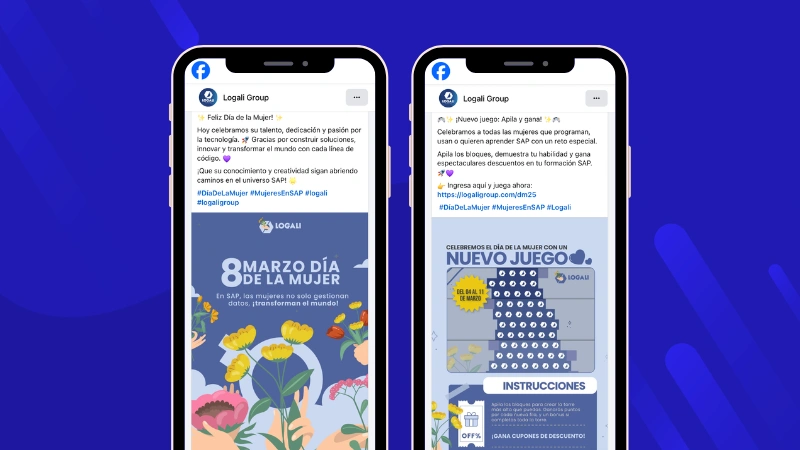
In the tower game, you have to stack building blocks or rows that appear from each side of the screen, and you have to click or tap when you want to stop the block. The part of the block that is not on top of the previous block disappears, and you now have less space to place the next block. While playing Logali’s game, you reach different levels of “SAP knowledge”: Explorer, Developer, Architect, and SAP Leader. The building blocks of the tower feature Logali’s logo. Participants had to reach 15 rows within 45 seconds, and they could try 12 times. There was a discount coupon on a SAP course for every participant, programmed as a direct prize. On average, each participant played the game 7,5 times.
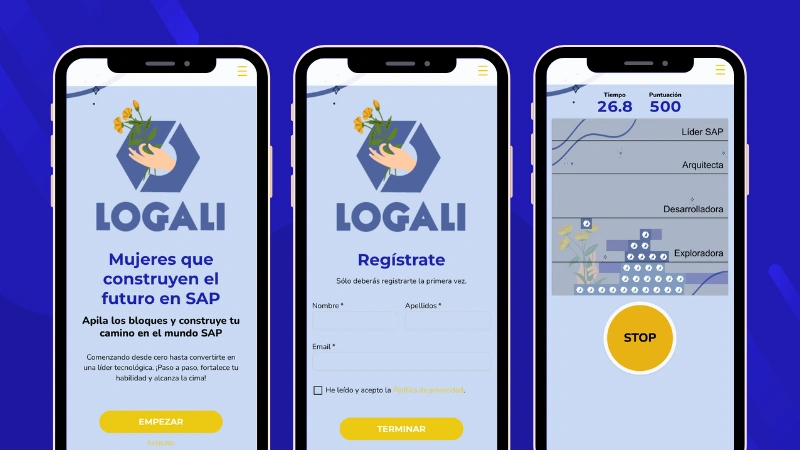
Another example of this type of game is the Slide & Match game from the cider brand Savanna Namibia for the Savanna Sound of Summer music festival. The beverage brand posted about the game before the festival dates on their very active social media profiles.
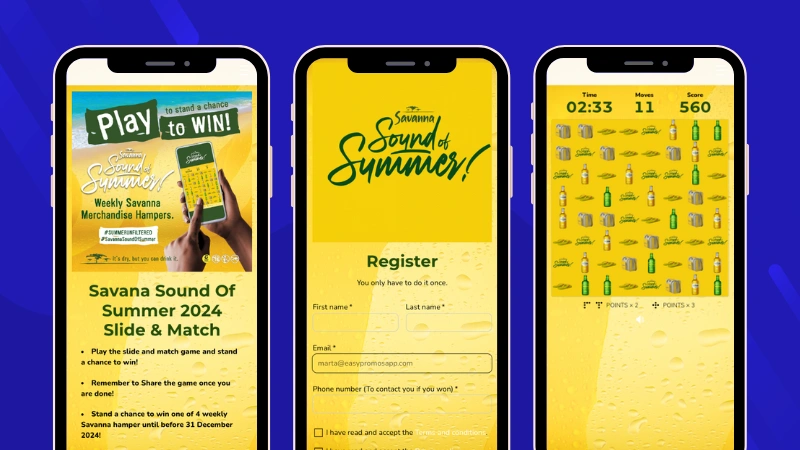
In this match-3 game, users had to combine three identical items in a row to score points, reaching 15 matches within the 3-minute time limit. The items were two different types of cider bottles, a cooler bag, flip-flops, and their logo, perfectly combined with a background image featuring drops of ice-cold cider, making you want to try it. Users could play the game 10 times per week, for each of the three weeks the game was open. Each user received one entry for the prize draw, which was used to find the winner, who received a Savanna merchandise hamper.
The last example is from Aruba Bank, which used the nation’s national day as the perfect excuse to launch a ‘Grab our Flag’ game, using the Tap Tap game to proudly showcase and celebrate the island’s flag. They caught the attention of social media users and followers by posting about the game on their profiles.
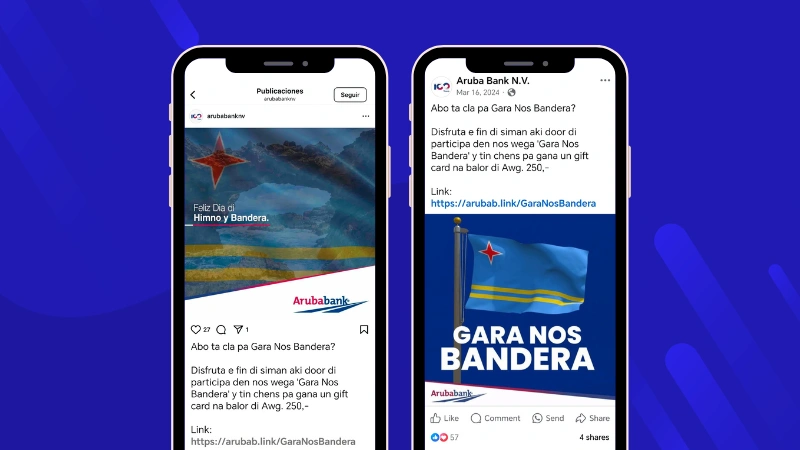
In the game, users had to tap the nation’s flag whenever it appeared in the cells, in front of a beautiful background image of the Arubian Hooiberg mountain and blue sky. But, users had to be careful not to tap the two other flags, the Bonaire and the Curaçao flags. Users could play the game 30 times during the participation period for the chance to win a cash prize.
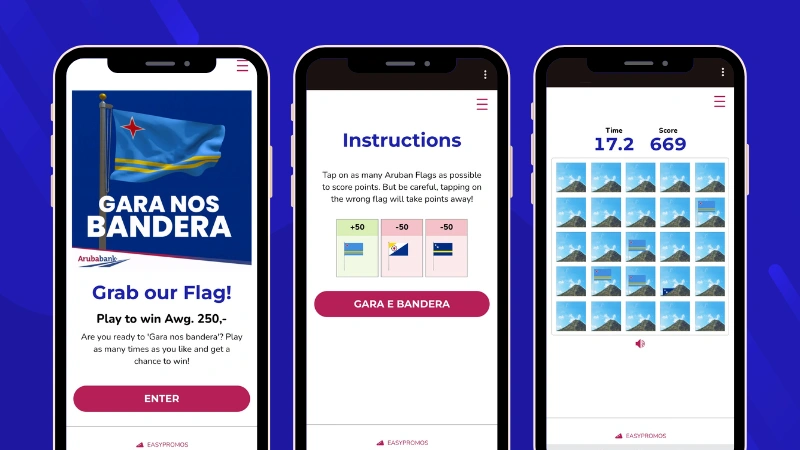
These video-style games are very popular, and we have yet another example. This one is from the environmental non-profit organization Signus Ecovalor, which specializes in the proper recycling of tires. The organization used the Falling Objects game to raise awareness about ocean waste, posting about the game that promised instant win vouchers and a final prize draw for a weekend stay at an eco-location.
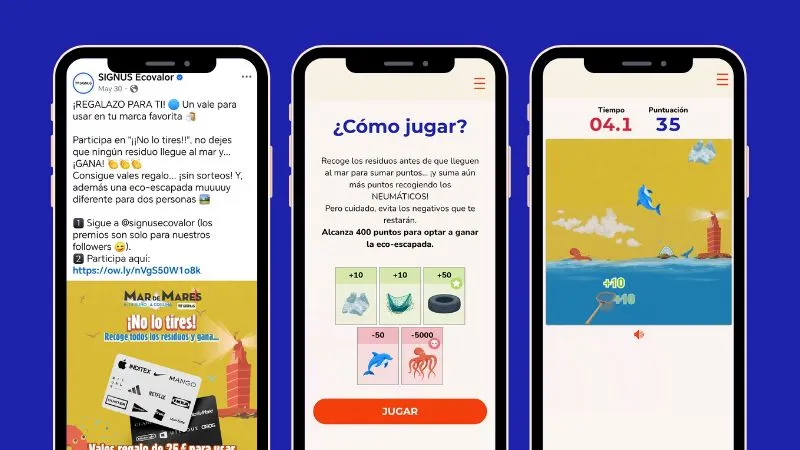
In the game, users have to catch the waste that falls, before it ends up in the ocean; plastic bags, fishing nets, and, of course, tires. But they had to be careful not to catch the dolphins and the octopi, or they would lose points. Users had to reach at least 400 points within 30 seconds to enter the prize draw, and they could try 5 times every day.
Word games
These games are perfect for educational or thematic content campaigns. They can be Word Search games, Crosswords, or Word Shuffle games. These kinds of games are great for teasing new products or launching a branded vocabulary challenge.
In this example, the sunglasses & eyewear store Más Visión México launched one of the latter to celebrate Valentine’s Day with their online audience. They used their social media profiles both to launch the Word Shuffle game and to announce the winners, which shows great transparency.
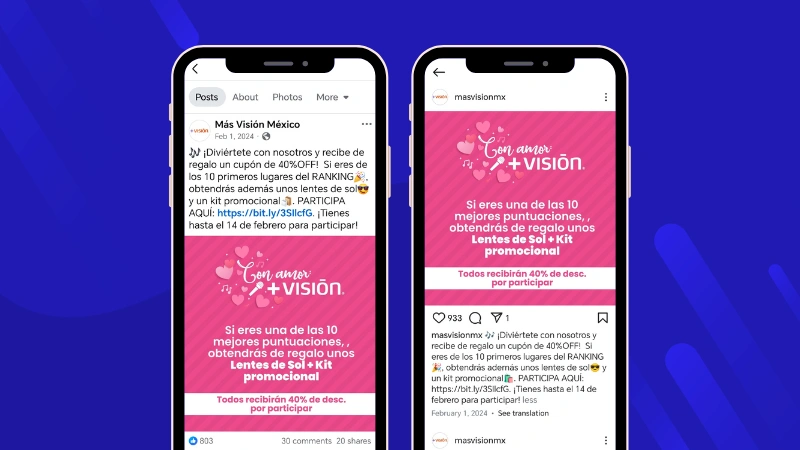
In the game, participants had to shuffle the letters to find the missing word in popular song titles. The users had 50 seconds to find the missing word in each of the 7 songs, all related to their business, containing words like ‘eyes’ and ‘looks’. As in this game, the solution is always the same, users could only play once. The first 10 players on the ranking won a pair of sunglasses and a promotional kit, and everyone who participated received a 40% discount voucher.
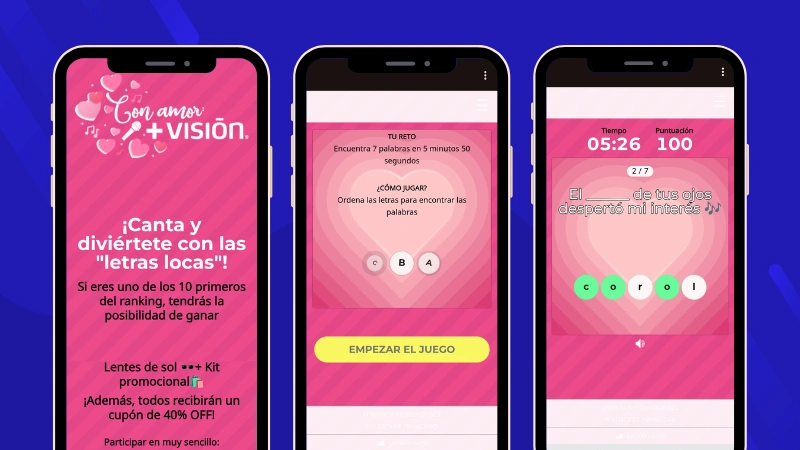
Social Media Quizzes
Quizzes serve both entertainment and educational purposes. With Easypromos, you can create different kinds of quizzes, such as Knowledge Quizzes, Quiz with Timer, Face Off quizzes, Pick your Favorite, and Like or Not. You can learn more about the Easypromos quizzes here.
How to set up and publish games on social media
With Easypromos, setting up a game is fast and easy, even without technical expertise or programming knowledge:
- Choose a game format.
Select from over 40 customizable game templates.
- Customize the game.
Add your logo, brand colors, messaging, and prize details. Upload your images and set the gameplay and rules.
- Set up registration and legal content.
Configure the fields to collect the data you need and set up consent checkboxes for the terms & conditions and privacy policy that you can easily add to the promotion site.
- Publish the game.
Share it as a link on your social media, embed it on your website, and link to your site from your social media, or run paid ads to boost reach.
- Analyze results.
Access dashboards to view participation stats, responses, and export data to your CRM or mailing lists.
Social Media Games Ideas
We hope all these social media game examples and ideas have inspired you. Before we finish, we wanted to share one more idea, which is also a good practice when you launch a social media game: reward users for their engagement. To get a high volume of participation, add a double incentive to participate in your branded game: fun and prizes.
With Easypromos, it’s easy to manage the prizes and the number of units you have of each, the assignment method, and fulfillment in the social media games. There are many different ways to give prizes. You can assign direct prizes just for playing, for example, discount vouchers. You can also assign prizes to the top 3 of the ranking, or run a random draw among all users who have completed the game.
Social media games aren’t just a fun distraction; they’re a strategic tool for lead generation, brand awareness, and data collection. By leveraging tools like Easypromos, brands can turn passive scrollers into engaged users and casual followers into loyal customers. The games are easy to implement, fun to play, and incredibly effective in converting social media engagement into real marketing value.
So, the next time you’re planning a campaign, don’t just post, play.
